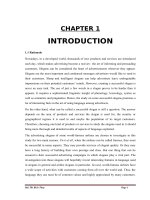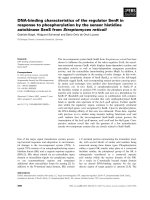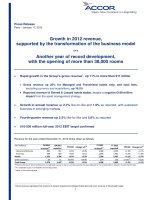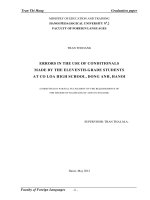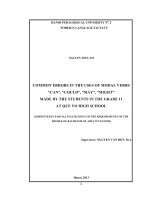Metaphors used in inaugural addresses made by the US presidents
Bạn đang xem bản rút gọn của tài liệu. Xem và tải ngay bản đầy đủ của tài liệu tại đây (771.37 KB, 14 trang )
Metaphors used in inaugural addresses made by
the US presidents
Phạm Thị Mai Oanh
Trường Đại học KHXH&NV
Luận văn ThS. Chuyên ngành: English Linguistics; Mã số: 60 22 15
Người hướng dẫn: Dr. Hà Cẩm Tâm
Năm bảo vệ: 2011
Abstract: This paper investigates typical conceptual metaphors used in inaugural
addresses made by the US president. The author tries to present the classical cognitive
theory of metaphor proposed by George Lakoff and Mark Johnson. Then, three inaugural
addresses made by the US presidents including addresses made by William Bill Clinton
(1993), George W. Bush (2001) and Barak Obama (2009) are analyzed using Lakoff’s
and Johnson’s theory. The metaphors are categorized in terms of ontological metaphor,
orientational metaphor and structural metaphor. The results of the study reveal that all
types of conceptual metaphor including ontological metaphor, structural metaphor and
orientational metaphor are used in four inaugural addresses. Ontological metaphors are
used with the highest frequency. Orientational metaphors are rarely used with the
smallest number. Entiy metaphor, which is a subtype of ontological metaphor, is the most
frequently used. These conceptual metaphors have definite emotional effect on the
audience to fullfil the purpose of delivering these inaugural speeches.
Keywords: Ẩn dụ; Tiếng Anh; Diễn văn; Tổng thống; Ngôn ngữ học; Mỹ
v
TABLE OF CONTENTS
Declaration …………………………………………………………………………
i
Acknowledgement …………………………………………………………………
ii
Abstract ……………………………………………………………………………
iii
Abbreviations used in the thesis ……………………………………………………
iv
Table of contents……………………………………………………………………
v
PART A: INTRODUCTION
1. Rationale …………………………………………………………………………
1
2. Aims of the study……………………………………………………… ………
3. Scope of the study………………………………………………………………….
4. Methods of the study ……………………………………………………………
5. Design of the study………………………………………………………………
PART B: DEVELOPMENT
Chapter 1: Theoretical background
1.1. The simile theory by Aristotle ……………………………………
1.2. The interaction theory by I.A Richard and Max Black ………………………
1.3. The classical cognitive metaphor theory by Lakoff and Johnson ……………
1.3.1. What is metaphor? …………………………………………………….
1.3.2. The nature of conceptual metaphor………………………………………….
1.3.3. Components of conceptual metaphor………………………………………
13.4. Classification of conceptual metaphor………………………………………
1.3.4.1. Ontological metaphor……………………………………………………….
1.3.4.1.1. Container metaphor ………………………………………………………
1.3.4.1.2. Substance metaphor ………………………………………………………
1.3.4.1.3. Entity metaphor …………………………………………………………
1.3.4.2. Orientational metaphor……………………………………………………
1.3.4.3. Structural metaphor ………………………………………………………
Chapter 2: The study
2.1. Research Questions……………………………………………………………
2.2. Data collection …… …………………………………………………………
2.3. Analytical framework…………………………………………………………
1
1
2
2
3
4
5
5
6
6
7
7
8
8
9
9
11
12
12
12
vi
2.4. Data analysis and discussion ………….………………………………………
2.4.1. Ontological metaphors ……………………………………………………….
2. 4 .2. Structural metaphors ………………………………………………………
2.4.3. Orientational metaphors …………………………………………………….
PART C: CONCLUSION
1. Major findings …………………………………………………………………….
2. Implications ………….……………………………………………………………
3. Suggestion for further studies…………………………………………………….
REFERENCES………………………………………………………………………
13
14
32
38
40
40
40
42
APPENDIX I
APPENDIX II
APPENDIX III
APPENDIX IV
1
SUMMARY OF THE THESIS
PART A: INTRODUCTION
1. Rationale
The use of metaphor as a part of figurative language aims to help the listeners
to visualize what is meant by a phrase or expression. Politicians use language to
persuade people that their thoughts, aims and ideas are equitable and to make their
point clear and vivid to the people. The president‟s inaugural addresses are delivered to
show the president‟s responsibility for the people‟s desires and demands, to gain the
people‟s support for the new government. Therefore, presidents have to use rhetorical
strategies to convince their citizens and metaphor is one of the rhetorical strategies
which are found to be commonly used in inaugural addresses. Thus, I would like to
conduct a study on the use of metaphor in inaugural addresses made by the US
presidents to find out what types of metaphor are commonly used and how effective
they are.
1. Aims of the study
This study was conducted to fulfill the following aims:
- to provide knowledge about conceptual metaphor from Lakoff and Johnson‟s
perspective.
- to investigate the use of conceptual metaphor in inaugural addresses made by
the US presidents and the implicit emotional influence of these metaphors on the
audience.
These aims of the study were achieved via the following research question:
What types of conceptual metaphors are used in inaugural addresses made by
the US presidents?
3. Scope of the study
Within this paper, I would like to focus my attention on theories of metaphor.
Cognitive theory about metaphor developed by Lakoff and Johnson will be presented
in details in terms of definition, nature, components and classification. Then four
inaugural addresses made by George H. W. Bush (1989), William Bill Clinton
(1993), George W. Bush (2001) and Barak Obama (2009) are analyzed using Lakoff
and Johnson‟s theory to find out typical conceptual metaphors in these speeches.
2
4. Methods of the study
A combination of both descriptive and explanatory methods was applied to
carry out this study. These two methods were used to collect data different books and
other sources available, describe the collected information and analyze the inaugural
addresses. The study was conducted as follows:
Firstly, data was collected from different books, websites about metaphor in
English.
Secondly, the collected information was synthesized and categorized.
Finally, the inaugural addresses were analyzed in terms of metaphor.
5. Design of the study
This study consists of three parts. Part A, entitled “INTRODUCTION”,
presents the rationale, aims, scope, methods and design of the study. Part B, entitled
“DEVELOPMENT” comprises two main chapters. Chapter 1 deals with theoretical
background of the study including different theories of metaphor. Chapter 2 presents
the study of conceptual metaphors used in four inaugural addresses, possible
emotional effect the used metaphors may have on the audience. Part C Conclusion
focuses on major findings, implications and suggestions for further studies.
3
PART B: DEVELOPMENT
CHAPTER 1: THEORITICAL BACKGROUND
1.1. The simile theory by Aristotle
From Aristotle‟s point of view, metaphor is based on “seeing resemblances” in
things. According to Aristotle, metaphor is defined as a “transfer of a name belonging
elsewhere” (cited in Michiel Leesenberg, 2001:33). Metaphor is merely a substitute for
some other expressions, which expresses the same “cognitive content” if it is literally used.
“Thing” here refers not only to physical objects but also to any topic or thought. “Name”
here cannot be used in the sense of proper or common names but must be understood as
any sign.
Additionally, Aristotle privileges metaphor as the more generic figure of speech
and states that simile is actually the longer form of metaphor. Therefore, the meaning of a
metaphor is identified with that of the corresponding simile. As a result, metaphor “A is
B” is understood as “A is like B”.
In general, the theory of metaphor by Aristotle has both intuitive and
methodological motivations. However, we cannot either describe with certainty Aristotle‟s
theory as either semantic (i.e., involving words and their meaning) or pragmatic (i.e.,
involving the use of language). Significantly, his definition of metaphor does not involve
„referents” (things) or “meanings” (concepts). On his view, metaphors just involve a
relocation of words, and his definition does not yet yield any precise doctrine as to how the
interpretation of metaphor works.
1.2. The interaction theory by I.A Richard and Max Black
The interaction theory of metaphor is one of the earliest modern alternatives to the
simile theory by Aristotle. By this theory, two authors mean that metaphor does not only
express similarities but also creates similarities. Metaphor is considered existing at
sentence level in this theory. More importantly, metaphor is seen as a cognitive
phenomenon rather than a purely rhetorical device. This cognitive phenomenon is made
by the interaction between different cognitive systems.
I.A Richards is the first person to develop the interaction model of metaphor. In his
book “The philosophy of rhetoric” (1936), he indicates that metaphor is a cognitive
phenomenon that works not on the level of word combination but it arises from the
interactions between the conceptual structures underlying words. Metaphor is considered a
4
cognitive phenomenon involving concepts. In this theory, metaphor is moved from word
level to level of concepts.
According to Max Black, metaphor is not an isolated item but it is considered a
sentence. A metaphorical sentence involves two subjects which are identified as the
principal and the secondary. The primary subject is the frame which is the literal
surrounding. The secondary (the metaphor) entails the focus-a system of associated
commonplaces of the metaphorical word. The secondary subject (the metaphor) connects a
system of associated commonplaces (or a system of associated stereotyped information) to
the frame which is the primary subject.
To sum up, this theory offers three new points. Firstly, metaphor creates
similarities. Secondly, metaphor is considered to possess “cognitive content” existing at
sentence level. Finally, this cognitive content is produced by the “interaction” between
different cognitive systems. By this theory, metaphors are proved to function as powerful
cognitive tools.
1.3. The classical cognitive metaphor theory by Lakoff and Johnson
1.3.1. What is metaphor?
George Lakoff and Mark Johnson claim that metaphor is primarily an issue of
conceptualization. Metaphors are defined as “mappings across conceptual domains” in
which „the image- schemata structure of the source domain is projected onto the target
domain in a way that is consistent with inherent target domain structure” (Lakoff,
1993:245). In “Metaphors We Live By” by Lakoff and Johnson (1980) metaphor is seen as
a process by which we conceive “one thing in terms of another and its primary function is
understanding”. In fact, metaphor is considered the interaction between a source domain
and a target domain in the conceptual process rather than the interaction between two
words only.
1.3.2. The nature of conceptual metaphor
First of all, metaphors are proved to be pervasive everywhere. Lakoff realizes that
metaphor does not only exist in poetry but we use them all the time and use them in a far
more encompassing manner. Metaphors are a part of everyday language, integral and
important to understanding because “most of our ordinary conceptual system is
metaphorical in nature” (Lakoff and Johnson, 1980:4. Obviously, metaphor is pervasive
and people use metaphors without noticing it.
5
Secondly, metaphor is claimed to be based on embodied human experience. We
make sense of less directly apprehensible experiences on the basis of more directly
apprehensible experiences. From cognitive perspective, language is not structured
arbitrarily. It is motivated and grounded more or less directly in experience, in our bodily
physical, social, and cultural experiences. Mental and linguistic categories are abstract,
disembodied. People create them on the basis of their concrete experiences and under the
constraints imposed by their bodies.
1.3.3. Components of conceptual metaphor
According to Lakoff and Johnson, metaphor is seen as a cognitive mechanism
whereby one conceptual domain is partially mapped onto a different conceptual domain.
The second domain is partially understood in terms of the first one with the linguistic
metaphor deriving from those domains.
The domain that is mapped is called the source domain/ donor domain.
The domain onto which it is mapped is target domain/ recipient domain.
1.3.4. Classification of conceptual metaphor
Lakoff and Johnson classify metaphor into three main types including ontological,
orientational and structural metaphor.
1.3.4.1. Ontological metaphor
Lakoff and Johnson reasoned that ontological metaphors occurred when our
experience of physical objects and substances provided a further basis for understanding.
This means that we understand many abstract experiences (such as events, activities,
emotions and ideas) in terms of concrete substances, objects and processes. Therefore,
ontological metaphors involve ways of viewing intangible concepts as entities. Identifying
these abstract and indefinable non-entities as substances or entities make it possible too
“refer them, categorize them, group them, and quantify then- and by this means reason
about them” (Lakoff and Johnson, 1980: 25). One thing to notice is that because most
ontological metaphors are so fundamental to out thought and language, they are not often
identified as metaphors anymore.
In short, ontological metaphors help us to represent an abstract thing in terms of
something concrete such as an object, substance, container or person. In more details,
ontological metaphor is subdivided into container metaphor, substance metaphor and entity
metaphor.
6
1.3.4.1.1. Container metaphor
Container metaphor is an ontological metaphor in which some concept is
represented as
- having something inside and outside
- being capable of hiding something else
This means that non-physical objects are transformed into physical objects with
define boundaries.
1.3.4.1.2. Substance metaphor
Substance metaphor is an ontological metaphor in which an abstraction such as an
event, activity, emotion or idea is represented as material substance.
1.3.4.1.3. Entity metaphor
Entity metaphor is created when an abstraction is presented as a concrete physical
object.
A subtype of entity metaphor is personification in which a thing or abstraction is
represented as a person. Here, human characteristics are imposed on inhuman experiences.
In short, ontological metaphor is a metaphor in which an abstraction such as an
activity, an emotion, state or idea is represented as something concrete such as an object,
substance, container or a person.
1.3.4.2. Orientational metaphor
Orientational metaphor is a metaphor in which concepts are spatially related to each
other. Orientational metaphor organizes a whole system of concepts with respect to
another. Orientational metaphor explains a concept in terms of space or “give a concept a
spatial orientation” ( Lakoff and Johnson, 1980: 15). Most of orientational metaphors relate
to spatial orientation such as up-down, in-out, deep-shallow, on-off, central-peripheral.
Orientational metaphors are not arbitrary. They have a basis in our physical and
cultural experience.
1.3.4.3. Structural metaphor
Structural metaphors concern characterizing the structure of a concept by
comparing it to the structure of another concept. In other words, a structural metaphor is
created when one concept is understood in terms of another structured, sharply defined
concept. According to Lakoff and Johnson, structural metaphors are considered the most
complex type of conceptual metaphor because they require readers and hearers to transfer
7
one basic domain of experience to another basic domain. This process is called “a cross-
domain mapping in the conceptual system”. The mapping happens between the source
domain and the target domain.
It is said that this kind of metaphor is “embedded in the conceptual framework of
our culture”. This mean that structural metaphors are results of how we view the world
around us.
In summary, Lakoff and Johnson‟s contributions play an important role in the
development of cognitive theory about metaphor. Their theory about conceptual metaphor
has been the basis for a number of studies on metaphor. An analysis of conceptual
metaphors used in inaugural addresses made by the US presidents will be clearly presented
in the next chapter in the light of this theory.
8
CHAPTER 2: THE STUDY
2.1. Research questions
The study was conducted to answer the following question:
What types of conceptual metaphors are used in inaugural addresses made by the
US presidents?
2. 2. Data collection
Data were collected from four inaugural addresses made by George H.W Bush
(1989), Bill Clinton (1993), George W. Bush (2001) and Barack Obama (2009).
2.3. Analytical framework
The analytical framework used in this study is based on classical cognitive theory
of metaphor by Lakoff and Johnson as follows
Kinds of metaphor
Description
Examples
1.Ontological
metaphor
Con. Met
Non-physical objects
are transformed into
physical objects with
define boundaries.
1. I‟ve had a full life.
2. Life is empty for him.
Sub. Met
An abstraction such as
an event, activity,
emotion or idea is
represented as a
material substance.
VITALITY IS A SUBSTANCE.
1. She‟s overflowing with vitality.
2. I don‟t have any energy left at
the end of the day.
Ent. Met
An abstraction is
represented as a
concrete physical object
or a person.
1. I was magnetically drawn to
her.
(LOVE IS A PHYSICAL
ELETROMAGNETIC FORCE)
2. His religion tells him he can‟t
drink wine.
(RELIGION AS A PERSON)
2.Orientational metaphor
Concepts are spatially
related to each other.
HAPPY IS UP, SAD IS DOWN
1. I‟m feeling up.
2. My spirit sank.
9
3.Structural metaphor
One concept is
understood in terms of
another structured,
sharply defined
concept.
LIFE IS A JOURNEY
I‟m at a crossroads in my life.
2.4. Findings
All types of conceptual metaphor including ontological metaphor, structural metaphor
and orientational metaphor are used in four inaugural addresses. Ontological metaphors are
used with the highest frequency. Orientational metaphors are used with the smallest
number.
In terms of ontological metaphor, entity metaphors are used the most. The number
of entity metaphors in Barack Obama‟s address is the biggest and that of the three other
addresses is relatively the same. Container metaphors are rarely used with the smallest
number. Substance metaphors are not favourably used by four presidents. A great number
of abstract concepts are conceptualized as objects. The concepts including time, will, ideal,
politics, faith, interest, spirit, life, ambition, success, strength, challenge are frequently
conceptualized as objects. Furthermore, a great number of personification metaphors are
also exploited in four addresses. Nation, world, time and idea concepts are personified
which are used with the high frequency.
In terms of structural metaphor, George W Bush uses the biggest number of
structural metaphor. The second biggest number of this kind of metaphor is found in
William Bill Clinton‟s address. Barack Obama and George H.W Bush use the same
number of structural metaphor. Of all structural metaphors, changes as development,
development as a struggle, world as community, unity as development and politics as a
journey are frequently used.
10
PART C: CONCLUSION
1. Implications
As discussed above, all types of conceptual metaphor can be found in four inaugural
addresses with the biggest number of entity metaphor. These metaphors create certain
effect on the audience. Therefore, people should employ conceptual metaphors in their
written or spoken texts to convey the implicit meaning. More specifically, entity metaphor
and structural metaphor should be frequently used to make abstract things easier to be
understood and interpreted. On the other hand, conceptual metaphors should be paid much
attention when analyzing texts to arrive at the hidden meaning of the texts.
3. Suggestions for further studies
Due to the limitation of time, this study only focuses on typical types of conceptual
metaphors proposed by Lakoff and Johnson in four inaugural addresses. Thus, further
studies should be made on metaphors classified in terms of similarity, time and parts of
speech in four inaugural addresses.
The study is mainly concerned with types of conceptual used in four inaugural
addresses. Therefore, emotional effect that these addresses create on the audience should
be investigated in other studies.
Other figures of speech such as metonymy, synecdoche, and simile in these
addresses should be also discussed in other studies.
42
REFERENCES
1. Dirver R. & Roings R. (2003), Metaphor and Metonymy in Comparison and Contrast,
Mouton de Gruyter. Berlin, New York .
2. Higara M. K. (2005), Metaphor and Iconicity. A cognitive approach to Analyzing texts,
Printed and bound in Great Britain by Antony Rowe Ltd, Chippenham & Eastbourne.
3. Lakoff G. & Johnson M. (1980), Metaphors We live by, Chicago University Press,
Chicago and London.
4. Lakoff G. & Turner M. (1989), More than Cool Reason, Chicago University Press.
5. Lakoff G. (1993), The Contemporary theory of Metaphor, Cambridge University Press,
Cambridge.
6. Leezenberg M. (2001), Contexts of Metaphor, University of Amsterdam, Elsevier
Science Ltd, the Netherlands.
7. Richards I.A (1936), The philosophy of rhetoric, Oxford University Press, London.
8. Websites
